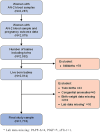Maternal serum biomarkers of placental insufficiency at 24-28 weeks of pregnancy in relation to the risk of delivering small-for-gestational-age infant in Sylhet, Bangladesh: a prospective cohort study
- PMID: 38858611
- PMCID: PMC11163798
- DOI: 10.1186/s12884-024-06588-8
Maternal serum biomarkers of placental insufficiency at 24-28 weeks of pregnancy in relation to the risk of delivering small-for-gestational-age infant in Sylhet, Bangladesh: a prospective cohort study
Abstract
Background: Small-for-gestational-age (SGA), commonly caused by poor placentation, is a major contributor to global perinatal mortality and morbidity. Maternal serum levels of placental protein and angiogenic factors are changed in SGA. Using data from a population-based pregnancy cohort, we estimated the relationships between levels of second-trimester pregnancy-associated plasma protein-A (PAPP-A), placental growth factor (PlGF), and serum soluble fms-like tyrosine kinase-1 (sFlt-1) with SGA.
Methods: Three thousand pregnant women were enrolled. Trained health workers prospectively collected data at home visits. Maternal blood samples were collected, serum aliquots were prepared and stored at -80℃. Included in the analysis were 1,718 women who delivered a singleton live birth baby and provided a blood sample at 24-28 weeks of gestation. We used Mann-Whitney U test to examine differences of the median biomarker concentrations between SGA (< 10th centile birthweight for gestational age) and appropriate-for-gestational-age (AGA). We created biomarker concentration quartiles and estimated the risk ratios (RRs) and 95% confidence intervals (CIs) for SGA by quartiles separately for each biomarker. A modified Poisson regression was used to determine the association of the placental biomarkers with SGA, adjusting for potential confounders.
Results: The median PlGF level was lower in SGA pregnancies (934 pg/mL, IQR 613-1411 pg/mL) than in the AGA (1050 pg/mL, IQR 679-1642 pg/mL; p < 0.001). The median sFlt-1/PlGF ratio was higher in SGA pregnancies (2.00, IQR 1.18-3.24) compared to AGA pregnancies (1.77, IQR 1.06-2.90; p = 0.006). In multivariate regression analysis, women in the lowest quartile of PAPP-A showed 25% higher risk of SGA (95% CI 1.09-1.44; p = 0.002). For PlGF, SGA risk was higher in women in the lowest (aRR 1.40, 95% CI 1.21-1.62; p < 0.001) and 2nd quartiles (aRR 1.30, 95% CI 1.12-1.51; p = 0.001). Women in the highest and 3rd quartiles of sFlt-1 were at reduced risk of SGA delivery (aRR 0.80, 95% CI 0.70-0.92; p = 0.002, and aRR 0.86, 95% CI 0.75-0.98; p = 0.028, respectively). Women in the highest quartile of sFlt-1/PlGF ratio showed 18% higher risk of SGA delivery (95% CI 1.02-1.36; p = 0.025).
Conclusions: This study provides evidence that PAPP-A, PlGF, and sFlt-1/PlGF ratio measurements may be useful second-trimester biomarkers for SGA.
Keywords: Bangladesh; Biomarkers; Cohort study; Placental growth factor; Placental insufficiency; Pregnancy-associated plasma protein-A; Serum soluble fms-like tyrosine kinase-1; Small-for-gestational-age.
© 2024. The Author(s).
Conflict of interest statement
The authors declare no competing interests.
Similar articles
-
Placental growth factor and soluble fms-like tyrosine kinase-1 are useful markers for the prediction of preeclampsia but not for small for gestational age neonates: a longitudinal study.Eur J Obstet Gynecol Reprod Biol. 2013 Dec;171(2):225-30. doi: 10.1016/j.ejogrb.2013.08.040. Epub 2013 Sep 4. Eur J Obstet Gynecol Reprod Biol. 2013. PMID: 24035323
-
Soluble fms-like tyrosine kinase to placental growth factor ratio in different stages of early-onset fetal growth restriction and small for gestational age.Acta Obstet Gynecol Scand. 2021 Jan;100(1):119-128. doi: 10.1111/aogs.13978. Epub 2020 Sep 14. Acta Obstet Gynecol Scand. 2021. PMID: 32860218
-
A prospective observational multicenter cohort study of maternal serum sFlt-1 and PlGF concentration in prediction of adverse neonatal outcomes in small for gestational age newborns delivered ≥34 weeks of gestation.J Matern Fetal Neonatal Med. 2025 Dec;38(1):2456983. doi: 10.1080/14767058.2025.2456983. Epub 2025 Jan 29. J Matern Fetal Neonatal Med. 2025. PMID: 39880468
-
Biochemical tests of placental function versus ultrasound assessment of fetal size for stillbirth and small-for-gestational-age infants.Cochrane Database Syst Rev. 2019 May 14;5(5):CD012245. doi: 10.1002/14651858.CD012245.pub2. Cochrane Database Syst Rev. 2019. PMID: 31087568 Free PMC article.
-
The association between serum soluble fms-like tyrosine kinase-1, placental growth factor, and soluble fms-like tyrosine kinase-1/placental growth factor ratio in singleton pregnancy and placental abruption: a systematic review and meta-analysis.Am J Obstet Gynecol. 2025 Apr 15:S0002-9378(25)00227-3. doi: 10.1016/j.ajog.2025.04.020. Online ahead of print. Am J Obstet Gynecol. 2025. PMID: 40246188 Review.
Cited by
-
The Association of Placental Grading with Perinatal Outcomes: A Systematic Review and Meta-Analysis.Diagnostics (Basel). 2025 May 15;15(10):1264. doi: 10.3390/diagnostics15101264. Diagnostics (Basel). 2025. PMID: 40428256 Free PMC article. Review.
-
Impact of Placental Grading on Pregnancy Outcomes: A Retrospective Cohort Study.Healthcare (Basel). 2025 Mar 10;13(6):601. doi: 10.3390/healthcare13060601. Healthcare (Basel). 2025. PMID: 40150451 Free PMC article.
-
Maternal PlGF and sFlt-1 are Associated with Low Birth Weight and/or Small-for-Gestational Age Neonates in Pregnancy with or without Preeclampsia.AJP Rep. 2025 Mar 31;15(1):e36-e42. doi: 10.1055/a-2555-1742. eCollection 2025 Jan. AJP Rep. 2025. PMID: 40166700 Free PMC article.
References
-
- Schlaudecker EP, Munoz FM, Bardají A, Boghossian NS, Khalil A, Mousa H, et al. Small for gestational age: case definition & guidelines for data collection, analysis, and presentation of maternal immunisation safety data. Vaccine. 2017;35(48):6518–6528. doi: 10.1016/j.vaccine.2017.01.040. - DOI - PMC - PubMed
-
- Lee AC, Katz J, Blencowe H, Cousens S, Kozuki N, Vogel JP, et al. National and regional estimates of term and preterm babies born small for gestational age in 138 low-income and middle-income countries in 2010. Lancet Glob Health. 2013;1(1):e26–36. doi: 10.1016/S2214-109X(13)70006-8. - DOI - PMC - PubMed
-
- Lee AC, Kozuki N, Cousens S, Stevens GA, Blencowe H, Silveira MF, et al. Estimates of burden and consequences of infants born small for gestational age in low and middle income countries with INTERGROWTH-21st standard: analysis of CHERG datasets. BMJ. 2017;358: j3677. doi: 10.1136/bmj.j3677. - DOI - PMC - PubMed
MeSH terms
Substances
LinkOut - more resources
Full Text Sources
Miscellaneous


